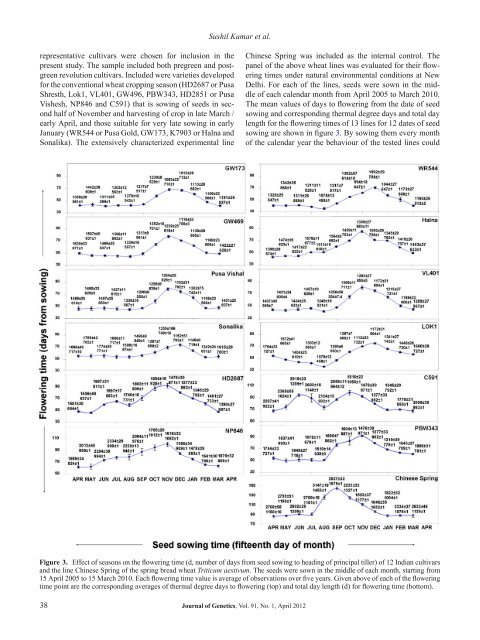Genetics of flowering time in bread wheat Triticum aestivum - Indian ...
Genetics of flowering time in bread wheat Triticum aestivum - Indian ...
Genetics of flowering time in bread wheat Triticum aestivum - Indian ...
Create successful ePaper yourself
Turn your PDF publications into a flip-book with our unique Google optimized e-Paper software.
epresentative cultivars were chosen for <strong>in</strong>clusion <strong>in</strong> the<br />
present study. The sample <strong>in</strong>cluded both pregreen and postgreen<br />
revolution cultivars. Included were varieties developed<br />
for the conventional <strong>wheat</strong> cropp<strong>in</strong>g season (HD2687 or Pusa<br />
Shresth, Lok1, VL401, GW496, PBW343, HD2851 or Pusa<br />
Vishesh, NP846 and C591) that is sow<strong>in</strong>g <strong>of</strong> seeds <strong>in</strong> second<br />
half <strong>of</strong> November and harvest<strong>in</strong>g <strong>of</strong> crop <strong>in</strong> late March /<br />
early April, and those suitable for very late sow<strong>in</strong>g <strong>in</strong> early<br />
January (WR544 or Pusa Gold, GW173, K7903 or Halna and<br />
Sonalika). The extensively characterized experimental l<strong>in</strong>e<br />
Sushil Kumar et al.<br />
Ch<strong>in</strong>ese Spr<strong>in</strong>g was <strong>in</strong>cluded as the <strong>in</strong>ternal control. The<br />
panel <strong>of</strong> the above <strong>wheat</strong> l<strong>in</strong>es was evaluated for their <strong>flower<strong>in</strong>g</strong><br />
<strong>time</strong>s under natural environmental conditions at New<br />
Delhi. For each <strong>of</strong> the l<strong>in</strong>es, seeds were sown <strong>in</strong> the middle<br />
<strong>of</strong> each calendar month from April 2005 to March 2010.<br />
The mean values <strong>of</strong> days to <strong>flower<strong>in</strong>g</strong> from the date <strong>of</strong> seed<br />
sow<strong>in</strong>g and correspond<strong>in</strong>g thermal degree days and total day<br />
length for the <strong>flower<strong>in</strong>g</strong> <strong>time</strong>s <strong>of</strong> 13 l<strong>in</strong>es for 12 dates <strong>of</strong> seed<br />
sow<strong>in</strong>g are shown <strong>in</strong> figure 3. By sow<strong>in</strong>g them every month<br />
<strong>of</strong> the calendar year the behaviour <strong>of</strong> the tested l<strong>in</strong>es could<br />
Figure 3. Effect <strong>of</strong> seasons on the <strong>flower<strong>in</strong>g</strong> <strong>time</strong> (d, number <strong>of</strong> days from seed sow<strong>in</strong>g to head<strong>in</strong>g <strong>of</strong> pr<strong>in</strong>cipal tiller) <strong>of</strong> 12 <strong>Indian</strong> cultivars<br />
and the l<strong>in</strong>e Ch<strong>in</strong>ese Spr<strong>in</strong>g <strong>of</strong> the spr<strong>in</strong>g <strong>bread</strong> <strong>wheat</strong> <strong>Triticum</strong> <strong>aestivum</strong>. The seeds were sown <strong>in</strong> the middle <strong>of</strong> each month, start<strong>in</strong>g from<br />
15 April 2005 to 15 March 2010. Each <strong>flower<strong>in</strong>g</strong> <strong>time</strong> value is average <strong>of</strong> observations over five years. Given above <strong>of</strong> each <strong>of</strong> the <strong>flower<strong>in</strong>g</strong><br />
<strong>time</strong> po<strong>in</strong>t are the correspond<strong>in</strong>g averages <strong>of</strong> thermal degree days to <strong>flower<strong>in</strong>g</strong> (top) and total day length (d) for <strong>flower<strong>in</strong>g</strong> <strong>time</strong> (bottom).<br />
38 Journal <strong>of</strong> <strong>Genetics</strong>, Vol. 91, No. 1, April 2012

















